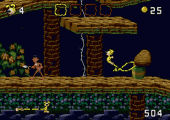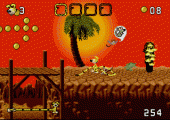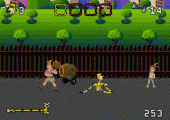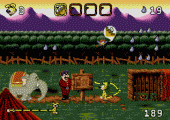Genre: Platformer Developer: Apache Software Publisher: Sega of America Players: 1 Released: 1996
You wouldn’t normally expect a Euro-centric property like Marsupilami to get a U.S. release, especially as late as 1996. Disney tried adapting André Franquin’s comic book creation for TV in 1993, but the show only lasted one season and ended well before this Genesis cartridge hit store shelves in North America (after a European Mega Drive release in 1995). Perhaps that’s why Marsupilami has been largely overlooked to date, but now it’s time to assess the situation. Does this offbeat puzzle-platformer have hidden charms to offer, or should it have stayed in the pouch?
You play as the title marsupial, accompanied by your elephant pal Bonelli. Your happy life in the jungle was shattered when the evil hunter Bring M. Backalive abducted the two of you from South America, forcing you to perform with his traveling circus in Europe. As the game begins, you’ve just broken out of your cages and are ready to escape. (If you’re thinking “Wait, an elephant in South America?”, blame Disney, who added his character to the mix — though in the cartoon, he’s named Stewart.)
Your main mission is to make the journey home with Bonelli through the game’s eight levels. Along the way you also need to save your three kids, who were caught by Backalive when they tried to rescue you. Return without them and, as the manual warns, you’ll “have to deal with Mrs. Marsupilami, and she won’t be happy – beware!”
After the circus, you’ll trek through the Alps and a construction site before crossing the ocean to the Americas, where your destinations include levels set in a theme park, the fictional country of Palombie, and ultimately Marsupilami’s jungle home. Each level has three stages, followed by a boss battle with goofy adversaries that range from a clown car to a denture-wearing shark. Win the boss fight, and you’re rewarded with one of two bonus mini-games that give you a chance to earn an extra life, followed by a password to the next level (more on that later).
The basic gameplay in Marsupilami is simple enough: lead Bonelli to the exit at the right-hand edge of the stage before time runs out. Your pachyderm friend plods slowly but steadily forward, and while a tail slap from Marsu will make him turn around, he can’t otherwise be directly controlled. You can drop a piece of fruit to temporarily delay him, but that only works for a few seconds.
Fortunately, Bonelli can’t be harmed or killed — but he can be frightened by enemies, stunned by rocks, or just blocked by obstacles. Any of these will make him turn around and walk back the way he came, which can be disastrous if you’ve carefully led Bonelli to a high platform, only to have an overlooked enemy startle him into tumbling off the edge and back to the ground floor.
The key to all progress is Marsupilami’s tail, used to attack enemies and build temporary bridges for Bonelli. All stages offer up to four selectable “tail options” to transform your tail into a shield, a parachute, a set of stairs for Bonelli to climb, a winch to hoist him up, or even a mouse to scare Bonelli into running away and crashing through obstacles. Some areas require you to manipulate the environment by moving a rock, hitting a switch, or breaking a stalactite. You can also jump on Bonelli’s back if you need a platform, or for another reason too (I wouldn’t want to spoil the first puzzle).
A typical stage in Marsupilami has you running ahead of Bonelli to defeat enemies and collect tail options, then using those options — plus your reflexes and ingenuity — to ferry him past the physical obstacles in his path. Meanwhile, your kids are trapped in three randomly chosen stages (indicated by a cage icon on the stage’s splash screen), and if you don’t want a bad ending, you’d better find them all. Usually, the cages are easy to spot, sometimes ridiculously so, but once or twice they were hidden in a tricky, out-of-the-way location.
All this is harder than it sounds, especially with a time limit. It can be surprisingly tough to figure out how to get past the next obstacle, though on lower difficulties, Tignass the bird will fly by and give you hints. But make no mistake, Marsupilami is fairly difficult until you’ve learned all the levels and how to use the tail options. Even on Easy it took me quite a while to make much progress.
The game’s presentation is pretty solid. The box boasts that you’ll “feel like you’re playing a cartoon!”, and while that might be pushing it, Marsupilami is certainly a nice-looking game that seems well-tailored for the Genesis. The character art and animation are attractive, and backgrounds are clean and clear, with many humorous little details that add a nice touch.
Marsupilami‘s music is unmemorable, but to the game’s credit there’s a lot of it, with a new tune for just about every level. The digitized sounds are also extensive, and include yodels, seal barks, and belches, to name but a few. These generally sound good, though I did get tired of hearing Marsu’s grainy cry of “Houba!” at random times.
That said, a number of technical flaws drag the game down. Six-button controller support is included, but toggling between tail options with X and Z is too flaky to use — either there’s a delay, or it doesn’t respond at all — so it’s basically useless. Marsupilami also has that hyperactive jumping and screen scrolling you sometimes see in Western-developed games on the Genesis. It’s not a big problem, but on at least one occasion I wanted to finesse a particular jump and couldn’t (though, full disclosure, it was the wrong approach for that puzzle anyway).
Managing Bonelli gets annoying, as he’s constantly in motion and it’s tricky to get him in the right place at the right time. Using fruit to immobilize him is too crude, the hit detection for your tail slaps is erratic, and he’s very finicky about the placement of stairs. Trying to keep Bonelli on a tiny moving platform or getting him to climb the stairs you build for him, can be an exercise in frustration until you get the timing down.
The overall difficulty curve also doesn’t make much sense. While the last couple levels have a puzzle or two, they’re not as tough as the first few stages (the Alps are especially unforgiving). Marsupilami also uses up most of its clever ideas early on, so by the time you reach the halfway point, you’ll basically know what to expect from the rest of the game.
Marsupilami handles difficulty settings by shortening the time limit for each stage, and increasing the number of hits each enemy can take. Many developers did this to extend a game’s shelf life, but it’s a lazy tactic that leads to clunky, repetitive gameplay. One of the rewards of mastering a game is eventually being able to fly through the stages gracefully, but that’s impossible when, over and over again, you have to stop in your tracks to tail-club a seal a dozen times at point-blank range. The tighter time limit has a much bigger impact on earlier stages, which exacerbates the difficulty curve issue: once I got past the first four stages on hard mode, the rest was honestly pretty easy.
The password system is Marsupilami‘s biggest flaw, though it’s not that the passwords are long (they’re only four characters). It’s not even that they don’t record your difficulty setting, so that each password is the same whether you were playing on easy or hard (that’s unfortunate, yes, but typical). No, the problem is that the password doesn’t bother to record the number of Marsupilami’s kids that you’ve rescued — making it impossible to get a good ending unless you beat the game in one sitting. The manual doesn’t say anything about this, so I have no idea whether it’s meant to be part of the challenge, or just a stupid oversight. I pulled off a 1CC run on hard without too much trouble, but it’s still an irritating design flaw that’s likely to alienate many players.
Is Marsupilami fun, or worth playing? Well, at first, I’d have said a vehement “no,” since for the first couple hours I was really hating the game. Now, after beating it, I’m on the fence. Marsupilami can be frustrating, and the faults I mentioned earlier are very real. But it also shows some class in a few key ways: enemies don’t respawn, you never end up in unwinnable situations, and the stage design always seems to work out.
It reminds me somewhat of another game based on a European comic book property, Astérix and the Great Rescue, which most people hate, and I rather enjoyed. The issues are much the same in both games, with a tight time limit, puzzle-oriented stage design, and a fair dose of aggravation. Marsupilami doesn’t have Astérix‘s weird hit detection scheme but also doesn’t have its terrific soundtrack.
This may be Stockholm Syndrome talking, but I think the bottom line on Marsupilami is that it’s… okay. I have no idea who the target audience would have been, since it’s much too difficult for the few American kids who would’ve fondly remembered the cartoon. Marsupilami isn’t a great game and may not even rise to the level of a “good” one, but it’s a challenging title that shows some evidence of TLC, and beating it afforded me some satisfaction. Much as I wanted to at the beginning, I can’t quite dismiss it.
SCORE: 5 out of 10










Recent Comments